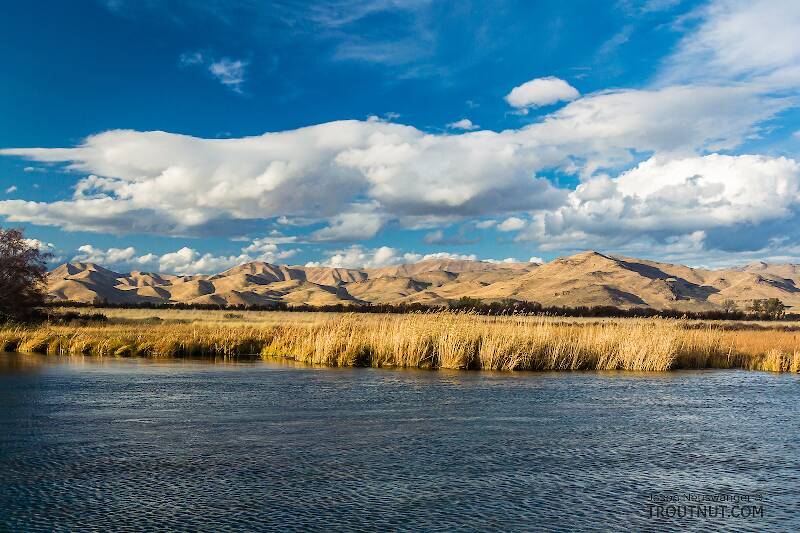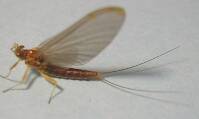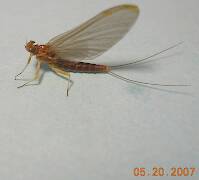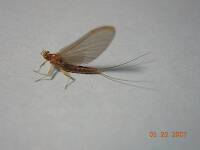
Hex Mayflies
Hexagenia limbata
The famous nocturnal Hex hatch of the Midwest (and a few other lucky locations) stirs to the surface mythically large brown trout that only touch streamers for the rest of the year.
Featured on the forum

This one was surprisingly straightforward to identify. The lack of a sclerite at the base of the lateral hump narrows the field quite a bit, and the other options followed fairly obvious characteristics to Clostoeca, which only has one species, Clostoeca disjuncta.

Troutnut is a project started in 2003 by salmonid ecologist Jason "Troutnut" Neuswanger to help anglers and
fly tyers unabashedly embrace the entomological side of the sport. Learn more about Troutnut or
support the project for an enhanced experience here.
Martinlf on Jun 27, 2020June 27th, 2020, 3:42 pm EDT
Perhaps Lee can help with this one. I seem to recall he had something to say about blue quills a few years back. Around noon on a small Central Pennsylvania spring creek I found clouds of what I'm relatively sure were blue quill spinners. It would have been heaven to have been there when they fell--if they fell on the water. Does anyone know about these spinners? The time of day they tend to drop, for example, and how to fish them?
"He spread them a yard and a half. 'And every one that got away is this big.'"
--Fred Chappell
--Fred Chappell
Taxon on Jun 27, 2020June 27th, 2020, 4:31 pm EDT
Hi Louis-
I would expect the spinner fall to occur in the evening as darkness approaches. Incidentally, Paraleptophlebia mollis was re-classfied as Neoleptophlebia mollis some years ago.
I would expect the spinner fall to occur in the evening as darkness approaches. Incidentally, Paraleptophlebia mollis was re-classfied as Neoleptophlebia mollis some years ago.
Martinlf on Jun 28, 2020June 28th, 2020, 10:53 am EDT
Thanks, Roger!!
"He spread them a yard and a half. 'And every one that got away is this big.'"
--Fred Chappell
--Fred Chappell
Wiflyfisher on Jun 29, 2020June 29th, 2020, 10:28 pm EDT
Louis,
Did you notice any females with egg sacks? I ask that because at times I have noticed on occasion swarming male spinners and no females. My guess is they are just excited and practicing for the big event.
Also, as i am sure you already know, dark cloudy weather can trigger a spinner fall.
Did you notice any females with egg sacks? I ask that because at times I have noticed on occasion swarming male spinners and no females. My guess is they are just excited and practicing for the big event.
Also, as i am sure you already know, dark cloudy weather can trigger a spinner fall.
John S.
https://WiFlyFisher.com
https://WiFlyFisher.com
Martinlf on Jun 30, 2020June 30th, 2020, 3:53 am EDT
John, I didn't get a close look at them. This spinner fall seems to be somewhat of a mystery. I've read and asked buddies about it, getting a variety of answers, but nobody seems to have figured it out for sure. I've heard that at least some of the spinners return to and fall on land. Part of the issue may be that the hatch comes in the summer, when many are either not fishing much, or primarily early, looking for cooled water or Tricos. There were just so many bugs, though, it made me want to figure out when and if they hit the water. I may head back up to the stream in the late afternoon to wait out the bugs and see if they fall in the evening. If the hatch is still going on. I may have just hit a peak day, and not find any bugs when I get back. Any experiences anyone has had, or knows about would be welcome.
"He spread them a yard and a half. 'And every one that got away is this big.'"
--Fred Chappell
--Fred Chappell
Quick Reply
Related Discussions
Topic
Replies
Last Reply
2
Jul 9, 2018
by Martinlf
by Martinlf
4
Dec 22, 2009
by Oldredbarn
by Oldredbarn
17
Apr 10, 2012
by Entoman
by Entoman
6
Nov 12, 2006
by Martinlf
by Martinlf
1
Sep 9, 2008
by GONZO
by GONZO
9
Apr 29, 2009
by Taxon
by Taxon







